
With the soaring popularity of the affectionate French Bulldog and brachycephalic breeds, there has been increasing research into Brachycephaly Obstructive Airway Syndrome (BOAS) globally.1 As described in our French Bulldog Breathing Issues blog post brachycephalic dogs can suffer from BOAS, which can be addressed with BOAS surgery. Whether you’re a current Frenchie owner or considering getting a Frenchie, this post will help you to understand BOAS surgery and prognosis.
In this post we’ll take you through:
- BOAS symptoms
- BOAS surgery
- What to expect on the day of surgery
- Complications
- Cost of surgery
What is BOAS?
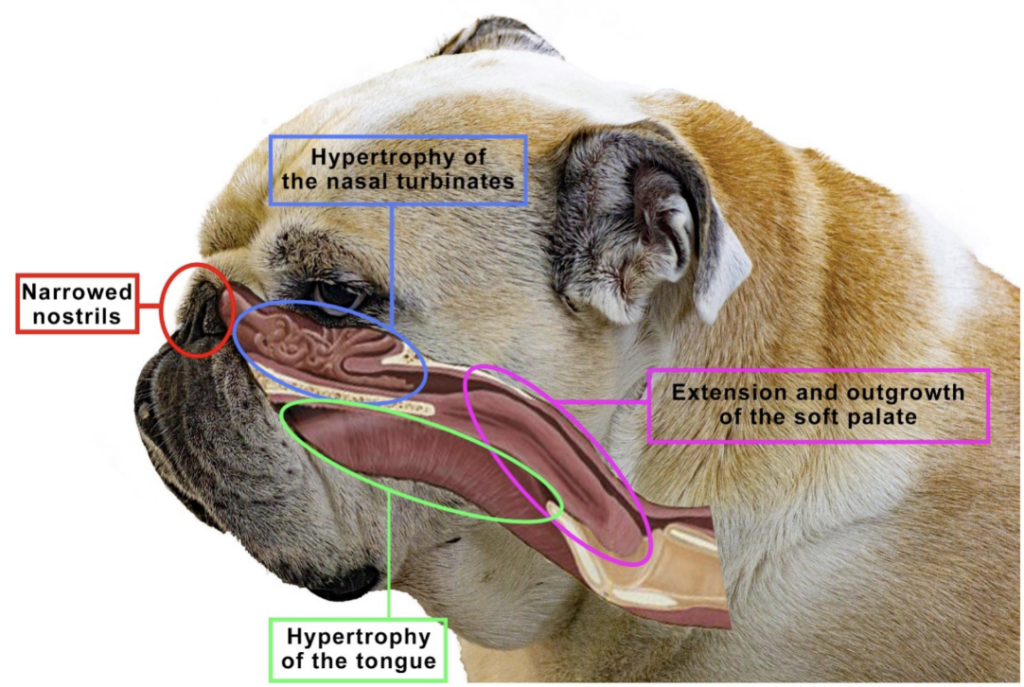
Brachycephalic Obstructive Airway Syndrome refers to the respiratory distress that is experienced by dogs with brachycephaly. The term “brachycephaly” or “brachycephalic” is used to describe the shortened facial structure that has resulted from generations of breeding by humans to create dogs with squished facial characteristics. Brachycephalic breeds include the French Bulldog, Pug, English Bulldog, Boston Terrier, Shih Tzu, Cavalier King Charles, and Shih Tzu.2 Symptoms of brachycephalic obstructive airway syndrome include:
- Heat stress
- Exercise intolerance
- Snoring & snorting noises
- Sleep apnoea
- Regurgitation & Vomiting
- Dyspnoea (difficulty breathing)
- Cyanosis (blue gums/tongue indicating a lack of oxygen in the bloodstream) & syncopal events (fainting)2
The symptoms of brachycephalic obstructive airway syndrome can be subtle and unfortunately considered “normal” for the breed. For example, the snorting noises that French Bulldogs commonly make when excited or when exercises are associated with their upper airway (nose, mouth, and entrance to the windpipe) obstruction caused by excessive soft tissue.2
Generations of breeding for a flattened face has resulted in a shortened skull, however the same amount of soft tissue remains. This causes obstruction of the upper airway with an enlarged tongue, tonsils, aberrant nasal turbinates, everted laryngeal saccules, and an elongated soft palate in these dogs. These obstructive tissues create resistance to airflow, generating increased negative pressure which causes secondary changes such as laryngeal collapse. This syndrome reduces these dog’s quality of life and can be life-threatening in severe cases.1,2
What is BOAS Surgery?
So how do veterinarians treat BOAS with surgery? There are many contributing components associated with BOAS as illustrated in the diagram below, however not all of these can be corrected surgically. As it is not possible to change the shape of the skull of these dogs, surgery aims to remove some of the enlarged soft tissue in the upper airway. There are several components to BOAS surgery, including alarplasty, staphylectomy, tonsillectomy and sacculectomy.2,3
Alarplasty
Alarplasty aims to address the stenotic nares (constricted nostrils) typically seen in brachycephalic dogs. There are two main procedures, the wedge alarplasty and the ala-vestibuloplasty. The wedge alarplasty technique involves taking a wedge of tissue from the outside wing of the nostril to widen the opening. The wedge is sewn closed by the surgeon with very fine, dissolvable suture material.3 The ala-vestibuloplasty is a newer technique that is being adopted by some BOAS surgeons which involves taking a larger section of tissue deeper into the nostril as well as a wedge of tissue on the nostril wing. This technique does not use any suture material and has been recommended to further improve airflow.2
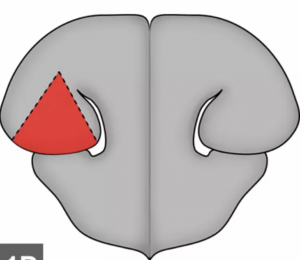
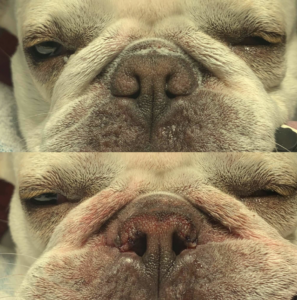
Staphylectomy
Staphylectomy refers to the removal of a portion of the elongated soft palate. If you run your tongue over the top part of your mouth you will feel the hard bony palate but as you reach the back of the mouth, you will feel it soften – this is the soft palate. In brachycephalic dogs, this commonly extends all the way to the entrance of the airway, blocking airflow and causing snorting and snoring. During a staphylectomy, the surgeon will thin and shorten the soft palate. This procedure may be performed using a special laser or with surgical instruments such as specialized scissors. If using the surgical instruments, your dog will have some dissolvable stitches placed in the shortened palate.
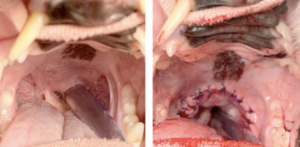
Tonsillectomy
The tonsils may become everted in brachycephalic dogs, which is thought to be secondary to negative airway pressure. Inflammation of the tonsils was also found in 20% of dogs with BOAS in one study, most commonly affecting the French Bulldog.2 The tonsils may be removed with cautery (a special blood vessel sealing device) or surgical instruments.7
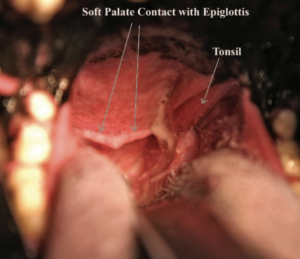
Sacculectomy
The laryngeal saccules sit at the entrance of the airway. If they are found to be everted and obstructing airflow your surgeon will delicately remove them.
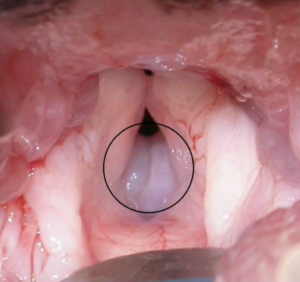
Additional Procedures
In severely affected individuals, additional surgery to remove additional tissue within the nostrils to further increase airflow can be considered. The LATE procedure, which stands for laser-assisted turbinectomy, involves using a special medical laser to remove abnormal, crowded tissue within the nasal cavity.8 Regrowth of tissue is common post-surgery however it has been demonstrated to be an effective treatment for dogs with intranasal abnormalities and poor response to the common surgical treatments previously discussed.8
What happens on the day of surgery?
One of the most common questions from owners is how long does BOAS surgery take? The exact answer to this question will depend on multiple factors, such as how many of the above procedures are being performed and whether any additional procedures such as chest x-rays or bronchoscopy are also being performed. BOAS surgery is a day procedure, which means that your dog is under anaesthesia for no more than 1-2 hours. Your veterinarian may prescribe medication for your dog to take prior to surgery and will advise of fasting procedures.
Generally, you will be advised to fast your dog overnight prior to surgery, which means they can have dinner but no breakfast on the day of surgery. Depending on your dog’s symptoms, your veterinarian may advise you to feed a small handful of food early in the morning prior to surgery. Once you get to the clinic, your dog will be admitted to hospital and all the pre-surgery checks will be performed.
Once recovered from surgery, your pet will be monitored very closely for any signs of difficulty breathing or regurgitating. Depending on several factors (surgeon assessment of your pet, recovery from surgery, type of clinic – 24hr vs GP), your dog may be discharged home the same day of surgery or may be advised to stay overnight for ongoing monitoring.
What to expect after surgery
Your pet will be discharged home with instructions from your surgeon. They will usually be required to wear an Elizabethan collar to prevent rubbing of the stitches on the nose. Your pet should be rested as advised by your surgeon, with no vigorous play, running or jumping. Your pet may also have a small amount of nasal discharge post-surgery. If you are at all concerned about the discharge, make sure to contact your veterinarian for advice. Finally, soft food is recommended post airway surgery.
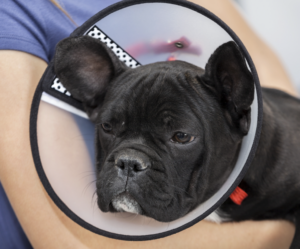
Complications – is BOAS surgery dangerous?
As with any surgical procedure, there are potential complications. Brachycephalic obstructive airway syndrome and gastro-oesophageal reflux carry risk for anaesthetic complications, however anaesthesia on these dogs is successfully performed daily in veterinary hospitals across the world.6
The main complications of airway surgery reported in one study included dyspnoea (difficulty breathing), regurgitation, aspiration pneumonia (inhalation of gastric contents) and respiratory or cardiac arrest. Difficulty breathing post-surgery can vary from mild, only requiring oxygen supplementation to more severe, requiring repeat anaesthetic to place a breathing tube down the throat.5
If there is persistent swelling of the airway, a temporary tracheostomy tube may be required. This is a procedure where an incision into the windpipe is made, and a tube placed to bypass the swollen airway.5 This allows your pet to breathe even when their upper airway is swollen. This tube usually stays in place for a couple of days until the swelling resolves and is removed once no longer required. While BOAS surgery does come with risks, the improved quality of life your pet needs to be strongly considered and your surgeon will provide their recommendations for your dog.
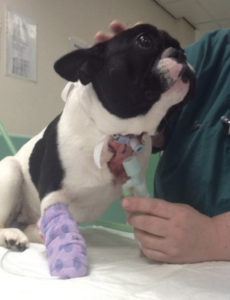
BOAS surgery cost
Although most owners would like to know how much brachycephalic airway syndrome surgery will cost, this will vary between veterinary practices.1 There will likely be a cost difference between specialist referral practices and primary care or general practices (GP’s). The difference in this cost is due to level of hospitalization provided (e.g. 24hr intensive care vs standard veterinary practice), qualifications of the surgeon and whether any other procedures are being performed (e.g. chest x-rays, bronchoscopy). Your regular veterinarian should be able to recommend BOAS surgeons in your area.
Given that nearly all brachycephalic dogs would benefit from surgery, it is strongly recommended that any prospective or current owners ensure that they take out pet insurance. It is important to read the product disclosure statement (PDS) closely when comparing pet insurance policies so that you are aware of any exclusions.
Unfortunately brachycephaly is associated with several other health conditions such as eye, dental, spinal, skin, and orthopedic disease.
Prioritizing pet insurance as part of your pet budget will ensure that if your French Bulldog develops any of these conditions, you are financially prepared to provide them with the best health care. Read on for more about French Bulldog health issues.
*Disclaimer: This article is not individualized for your pet and is not a substitute for professional veterinary advice. Please see your veterinarian for individualized recommendations.
Photo References
- Brachycephalic Obstructive Airway Syndrome
Buzek A, Serwańska-Leja K, Zaworska-Zakrzewska A, Kasprowicz-Potocka M. The shape of the nasal cavity and adaptations to sniffing in the dog (canis familiaris) compared to other domesticated mammals: A review article. Animals. 2022;12(4):517. doi:10.3390/ani12040517 - Wedge Alarplasty
Brachycephalic syndrome: Innovative Surgical Techniques [Internet]. [cited 2023 May 30]. Available from: https://digital.cliniciansbrief.com/article/brachycephalic-syndrome-innovative-surgical-techniques - Before and after alarplasty
Ahsan. Stenotic Nares augmentation [Internet]. [cited 2023 May 30]. Available from: https://www.metrovetchicago.com/services/surgery/stenotic-nares-augmentatio - Staphylectomy
Brachycephalic obstructive airway syndrome (BOAS) update [Internet]. 2022 [cited 2023 May 30]. Available from: https://www.ndsr.co.uk/insights/brachycephalic-obstructive-airway-syndrome-boas-update - Enlarged Tonsils
Techniques for Performing Corrective Surgery: Dogs with Brachycephalic Airway Syndrome [Internet]. [cited 2023 May 30]. Available from: https://todaysveterinarypractice.com/wp-content/uploads/sites/4/2016/06/T1401C09.pdf - Everted Laryngeal Saccules
CriticalCareDVM. Brachycephalic airway syndrome – a vexing airway problem [Internet]. 2015 [cited 2023 May 30]. Available from: https://criticalcaredvm.com/brachycephalic-airway-syndrome-a-vexing-airway-problem/ - Post BOAS Surgery
Boas surgery for Brachycephalic Dogs [Internet]. 2021 [cited 2023 May 30]. Available from: https://www.thevetpractice.com.au/blog/soft-palate-surgery-for-brachycephalic-dogs/ - Tracheostomy Tube
How to manage tracheostomy tubes [Internet]. The Veterinary Nurse. Available from: https://www.theveterinarynurse.com/review/article/how-to-manage-tracheostomy-tubes
